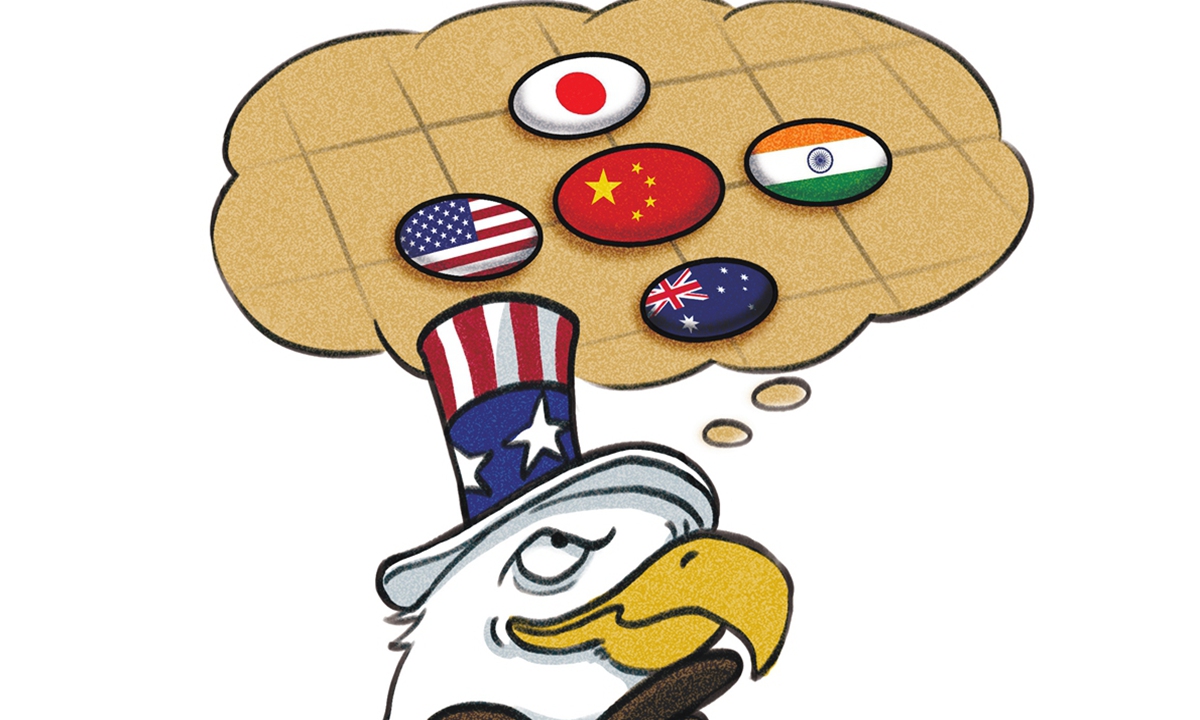
Illustration: Liu Rui/GT
The Exercise Malabar 2020 will witness the participation of all four QUAD countries - the US, Japan, Australia and India. This piece of news came on Monday when New Delhi announced that it had invited Canberra to participate, with the latter immediately affirming it would join.
Australia's participation is all about the Malabar naval exercise's vanity. It hardly establishes the QUAD's prowess as a formal military alliance. With the expansion of their military cooperation, the competition between the US and India over regional dominance seems to be breaking the surface.
Washington and New Delhi appear to be cooperating with each other more and more. But they cannot skirt issues of regional dominance.
The US has been hoping that Australia, Japan and India can coordinate with its Indo-Pacific Strategy. Yet New Delhi wants to maintain its independence strategically, diplomatically, and militarily while promoting its cooperation with Washington. This time, the invitation to Australia was sent by India, signaling a desire to consolidate its status in the group.
On the face of it, US-India cooperation seems to be growing closer. But essentially, India has no interest in joining or forming a US-led military alliance or coordinating the US' military strategy. India simply wants to showcase its military dominance in the India Ocean with the help of a seemingly enhanced cooperative move with other military powers.
However, the increased frequency of such military activity will only encourage India's desire to fight for greater regional dominance. For New Delhi, there can only be one power in the Indian Ocean. And it cannot be anyone else but India.
Some observers noted that India has hesitated about inviting Australia, but it ultimately comes in the context of the ongoing China-India border tensions. The move, moreover, mirrors India's calculation to gang up against China. But generally speaking, the temperature of China-India border row is cooling down, at least for the moment. New Delhi's moves are more about flaunting its ties with other military powers.
With closer cooperation with Australia, India can expand its military influence in both the Indian and the Pacific oceans. After all, apart from consolidating its dominance in the Indian Ocean, New Delhi also desires to become a more proactive and influential player in the Pacific region writ large.
India has its ambitions. It is not willing to become a subject to any other power, even the US. New Delhi believes it is on an equal footing with Washington.
This is why it is absolutely impossible to formalize the QUAD into a NATO-like alliance, or "Asian NATO." The US could establish an "Asian NATO" with Japan and Australia in the Western Pacific region. But such an aim won't be reached if Washington wants to count New Delhi in.
The US is in charge of NATO. All NATO members must coordinate with US strategy. India, on the other hand, has no desire to join such an alliance. It already has nuclear weapons, after all.
The territories and military bases of traditional NATO members are open to each other. Operations of US bombers, aircraft carriers and nuclear submarines can be carried out on the soil of other member states. They can also form multinational joint combat forces.
But the Malabar naval exercise merely focuses on anti-submarine warfare operations. It is hard to imagine that India will one day open up its military bases to US troops for permanent stationing. There are some port visits for warships between the two. But these are relatively low-level military exchanges.
Therefore, cooperation among the US, Japan, India and Australia has only been tactical. Their moves have not reached strategic levels.
Military and defense cooperation between Japan and India is subject to the will of the US. The coalition between Australia and India is superficial. There is no actual need for joint military projects between the two countries. After Australia joins the Malabar naval exercise, there will be more warships and more participant countries, which will only benefit the public images of India and the US.
As India and the US expand the scope of their military cooperation, the intensity for dominance in the Indian Ocean will only grow. Be it under QUAD or other frameworks of multilateral cooperation, India will always hope to play a dominant role in the Indian Ocean. India is not boosting its military abilities to become a willing subject to the US in an US-led military alliance.
The author is a Beijing-based military analyst. opinion@globaltimes.com.cn



